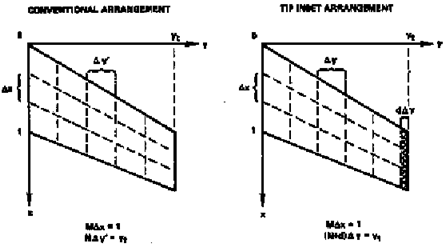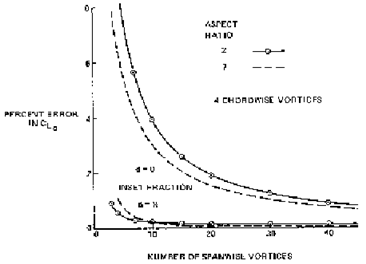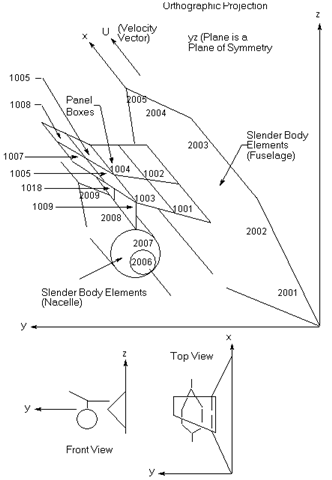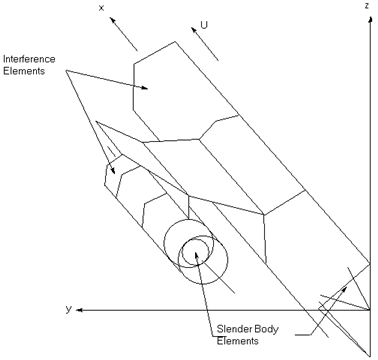XXXXXXXXXXXXXXXXXXXXXXXXXXXXXXXXXXXXXXXXXXXXXXXXXXXXXXXXXXXXXXXXXXXXXXXXXXXXXXXXXXXXXXXXXXXXXXXXXXXXXXXXXXXXXXXXXXXXXXXXXXXXXXXXXXXXXXXXXXXXXXXXXXXXXXXX''"> Aerodynamic Modeling Guidelines
Aerodynamic elements are regions of lifting surfaces or bodies. Since the elements occur in regular streamwise arrays, the Aerodynamic Modeling procedures of
Aero Modeling (Ch. 3) are to be used to generate the aerodynamic connection data (CAEROi) bulk data entries that specify these arrays to MSC.Nastran. The bulk data entries that comprise the aerodynamic model are discussed in this section, as well as guidelines for their creation.
For every aerodynamic problem, pertinent basic flight and geometric parameters are specified on the AEROS entry. This entry includes the Aerodynamic Coordinate System (input Options Input in the Aero Modeling module), the Reference Coordinate System (input as the Rigid Body Coord Frame as Global Data within the Aeroelasticity Module), the Reference Chord, Span and Area (also entered as Global Data), and the symmetry options (input as Trim Parameters as part of the subcase create in the Aeroelastic Analysis form of the Aeroelasticity module). Note that FlightLoads always requests the full reference area even though the AEROS entry needs the half model area for half-span model. The necessary translation occurs when the bulk data are created. A rectangular aerodynamic coordinate system must be identified. The flow is in the positive X‑direction in this system and parallel to the plane of the aerodynamic elements. The use of symmetry (or antisymmetry) is available to analyze structures that have both stiffness and inertial symmetry, to simulate ground effects, and to simulate wind tunnel wall effects. The planes of symmetry are taken from the aerodynamic coordinate system. The user must ensure that the aerodynamic reference system has the same symmetries. Any consistent set of units can be used for the dimensional quantities.
The types of elements available are shown in
Table A‑1. Every CAEROi entry must reference an aerodynamic property (PAEROi) data entry that is used to list additional parameters. Tabulations of numbers or other defining parameters are sometimes required, depending on the selected aerodynamic method, and these are listed on AEFACT entries. These lists include division points (for unequal box sizes) and a variety of other parameter values.
Table A‑1 Attribute | Aerodynamic Theory |
Doublet-Lattice Panel | Lifting Body (Interference) | ZONA51 Panel |
Bulk Data Entries | CAERO1 PAERO1 | CAERO2 PAERO2 | CAERO1 PAERO1 |
Mach Number | Subsonic | Subsonic | Supersonic |
Symmetry Options
(Aero flow coordinate system) | Two Planes y = 0 z = 0 | Two Planes y = 0 z = 0 | One Plane y = 0 |
Interaction | Panels and Bodies in the Same Group | Panels in the Same Group |
Interconnection to Structure | Box Centers | Slender Body Centers | Box Centers |
Displacement Components Used at Connection Points | 3,5 | 3,5 z-Bodies 2,6 y-Bodies | 3,5 |
Doublet-Lattice and ZONA51 Panels
The configuration is divided into planar trapezoidal panels (macro-elements), each with a constant dihedral and with sides parallel to the airstream direction. These panels are further subdivided into "boxes" (see
Figure A‑1), which are similarly configured trapezoids. The following guidelines are not enforced by the program; the user is expected to ensure adherence to these rules.
If a surface lies in (or nearly in) the wake of another surface, then its spanwise divisions should lie along the divisions of the upstream surface. The strips near the intersection of intersecting surfaces should have comparable widths. The aspect ratio of the boxes should be approximate unity; less than three is acceptable in the subsonic case, and of order one is desirable in the supersonic case. Boxes should be concentrated near wing edges and hinge lines or any other place where downwash is discontinuous and pressures have large gradients. [Note that concentrating boxes near hinge lines is a requirement of Potential Theory (which neglects viscous effects). Not increasing the concentration of boxes near hinge lines lowers the calculated control surface effectiveness and leads to closer agreement with experimental data.] The chord lengths of adjacent boxes in the streamwise direction should change gradually.
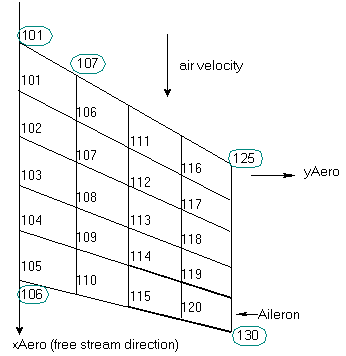
Figure A‑1 An Aerodynamic Doublet-Lattice/ZONA51 Panel Subdivided into Boxes. The number in the boxes are the aerodynamic grid IDS. The circled numbers are selected IDs for the aerodynamic mesh points.
Aerodynamic panels are assigned to interference groups. All panels within a group have aerodynamic interaction. The purpose of the groups is to reduce the computational effort for aerodynamic matrices when it is known that aerodynamic interference is important within the group but otherwise is negligible or to allow the analyst to investigate the effects of aerodynamic interference.
Each panel is described by a CAERO1 Bulk Data entry. A property entry PAERO1 is used to identify associated interference bodies in the subsonic case. A body should be identified as a member of the group if the panel is within one diameter of the surface of the body. The box divisions along the span are determined either by specifying the number of equal boxes NSPAN, or by identifying (by LSPAN), the AEFACT data entry that contains a list of division points in terms of fractions of the span. A similar arrangement is used to specify divisions in the chordwise direction by choosing NCHORD or LCHORD. The locations of the two leading edge points are specified in the coordinate system (CP) defined by the user (including basic). The sides (chords) are in the airstream direction (i.e. parallel to the X‑axis of the aerodynamic coordinate system specified on the AEROS Bulk Data entry). Every panel must be assigned to an interference group (IGID). If all panels interact, then IGID must be the same for all panels.
There is an aerodynamic grid point with its associated degrees of freedom in plunge and pitch for each box within a given panel. These points are located at the center of each box and are automatically numbered and sequenced by the program. The lowest aerodynamic grid point number for a given panel is automatically assigned the same number as specified for the panel ID field on the CAERO1 entry starting with the box connected to point 1. The grid point numbers increase in increments of 1 (see the CAERO1 Bulk Data entry description) first in the chordwise direction and then spanwise over all boxes in the panel. There are also corner grid points that are spawned in order to display the aerodynamic mesh. These grid IDs also begin with panel ID at point 1 and are incremented by 1, first in the chordwise and then the spanwise direction over all points on the mesh. (
Figure A‑1). Note that to insure uniqueness, panel IDs must be separated enough that mesh IDs do not overlap. For example, subsequent panel IDs associated with the panel given in
Figure A‑1 must be > 130. As a matter of practice, the user should always allow
more spacing in numbering so that, during mesh convergence studies, each panel can be independently incremented. The local displacement coordinate system has component T1 in the flow direction and component T3 in the direction normal to the panel in the element coordinate system defined on the CAERO1 entry.
Spanwise Convergence Criteria
Guidelines for modeling the spanwise cuts for the mesh can be gained from an investigation that was made of the steady case, i.e., the Vortex-Lattice Method (VLM) to which the DLM reduces at zero frequency. It showed slow convergence as the number of strips was increased. This has been observed in the past by Hough (Ref. 8 and Ref. 9) who showed improved convergence by following a suggestion of Rubbert (Ref. 14) that equally spaced lattices on a surface should be inset from the tip by a fraction of the lattice span. Hough observed that dramatically improves the convergence. It must be stressed that this inset entails a change in the lifting surface geometry and has the undesirable effect of making this geometry a function of the mesh.
Figure A‑2 Vortex-Lattice Layout
Figure A‑3 Lift-Curve Slope Convergence for Rectangular Wing
With a reasonable number of strips on a surface, say 20 to 30 the error is not large, perhaps 1 to 2% depending on the configuration, and the tip correction may not be worth the effort.
It should be noted that Hough’s argument leading to d=1/4 is based on a symmetrical (elliptical) loading in the steady case and with equal spanwise cuts. Limited calculations indicate that it is also valid in the antisymmetrical (in roll) loading, so the tip correction is recommended in general. Users are advised to perform some convergence checks, with and without the tip correction, they may also wish to investigate placing a refined spanwise mesh at the wing tip without the inset.
If users wish to make the tip correction they can reduce the span of the most outboard panel on each surface on the corresponding CAERO1 continuation entry by the factor NSPAN/(NSPAN + d) where NSPAN is the number of strips on the panel and d is the inset fraction (d = 0.25 is recommended).
Slender and Interference Bodies
In subsonic problems, bodies are idealized as "slender" and "interference" elements in combination. The primary purpose of the slender body elements is to account for the forces arising from the motion of the body, whereas the interference body elements are used to account for the interference among all bodies and panels in the same group. This is done by providing a surface through which the boundary condition of no flow is imposed. Bodies are further classified as to the type of motion allowed.
In the aerodynamic coordinate system, Y and Z are perpendicular to the flow. In general, bodies may move in both the Y- and Z-directions. Frequently, a body (e.g., a fuselage) lies on a plane of symmetry and only Z- (or Y‑) motion is allowed.
Note, however, that MSC.FlightLoads and Dynamics automatically captures the singularities. Thus a ZY-body on the XZ plane of symmetry in symmetric analysis will act as a Z-body without user interaction; in antisymmetric analysis, the same body will act as a Y-body. Thus, any model may contain Z-bodies, ZY‑bodies, and Y‑bodies.
One or two planes of symmetry or antisymmetry may be specified.
Figure A‑4 and
Figure A‑5 shows an idealization with bodies and panels. This example is the one used to illustrate the Doublet-Lattice program in Giesing, Kalman, and Rodden (1972b, pages 19-42). It has a fuselage, a wing, a pylon, and a nacelle.
Figure A‑4 Illustration of Boxes and Slender Body Elements. N5KA Bomber Example with Three Panels, Ten Boxes, Two Bodies, Nine Slender Body Elements, and Seven Interference Elements
Figure A‑5 Illustration of Interference Elements. N5KA Bomber Example with Three Panels, Ten Boxes, Two Bodies, Nine Slender Body Elements, and Seven Interference Elements
The PAERO1 Bulk Data entry lists the IDs of all the bodies that are associated (i.e., interfere) with a given Doublet-Lattice panel (CAERO1 entry). The CAERO2 entry specifies the geometry and divisions for the slender body and interference elements. The PAERO2 entry provides orientation and cross-section data for the slender body and interference elements as well as the sampling data to account for the residual flow discussed later. The location of the body nose and the length in the flow direction are given. The slender body elements and interference elements are distinct quantities and must be specified separately. At least two slender body elements and one interference element are required for each body. The geometry is given in terms of the element division points, the associated width, and a single height-to-width ratio for the entire body length. The locations of the division points may be given in dimensionless units or, if the lengths are equal, only the number of elements need be specified. The body may be divided along its length unequally to characterize the lift distribution, noting that Slender Body Theory gives a lift proportional to the rate of change of cross-section area. Shorter elements should be chosen at the nose where the area is changing rapidly; longer elements can be used along cylindrical regions where the area is constant and intermediate length elements can be used in transition regions. The semi-widths of the slender body at interference element boundaries can be specified separately and are given in units of length. Usually the slender body semi-width is taken as zero at the nose and is a function of X, while the interference body semi-width is taken to be constant.
The interference elements are intended for use only with panels and/or other bodies, while slender body elements can stand alone. Grid points are generated only for the slender body elements. The first grid point is assigned the ID of the body corresponding to the element at the nose and other grid points are incremented by one. The user should be cautious about the use of associated interference bodies since they increase computational effort significantly.
A brief review of the Method of Images (and its approximations) follows before the implementation of the method in MSC.Nastran is discussed.
The interference elements provide the basis for the internal image system that cancels most of the effects of the trailing vortices from the lifting surfaces. Because of the two-dimensional basis for this approximation (Thompson's Circle Theorem in Hydrodynamics), the body surface has been approximated by a constant elliptical cross-section cylinder called the interference tube. All panels that intersect a body must be attached to the interference tube. Image locations are computed from the semi-width of the interference tube for all lifting surfaces associated with the body. The image is only computed if it lies between the front and aft of the interference element for the associated body.
There is a residual flow "through" the body surface because the image system, being based on two-dimensional considerations, only partially cancels the flow through the body surface. It does not compensate for the effects of the bound vortices on the lifting surfaces or other bodies. Additional unknown "residual" doublets are located along the axis of the body, and, when determined, are added to the known doublet strengths of the slender body elements. The residual flow is calculated by "sampling" the vertical or side velocity components from the net effect of the surface, slender body, and image vortices or doublets. The sampling is performed at various angular positions around the periphery of the elliptical interference tube at the end points of the interference elements. The strengths of the "residual" doublets are then determined to cancel the net velocity.
The calculation of the velocity field induced by the residual doublets requires knowledge of the geometry of the cross section of the slender body at the end points of the interference elements. However, experience shows that the residual flow is small compared to the slender body flow field so that the residual flow need not be represented accurately. This permits the further approximation of simply using the geometry of the constant cross-section interference tube in the calculation of the velocities induced by the residual doublets.
A discussion of two related problems follows:
The requirement for a constant cross-section interference tube may require moving the stabilizer (or wing); see Giesing, Kalman, and Rodden (1972a, §2.5.8). MSC.Nastran can accommodate the requirements by specifying a stabilizer coordinate system, two sets of GRID points for the (same) stabilizer root and its fuselage connection, and MPCs constraining the motions of the two sets of GRIDs to be the same. In this way, the structure can be modeled faithfully although the aerodynamic model is only approximate. This is illustrated in the example "FSW Airplane with Bodies" (HA144F) in Chapter 7 of the MSC.Nastran Aeroelastic User’s Guide.
The idealization of a jet engine installation as a slender body results in a mass flow ratio through the engine of zero, since there is no flow through the body. Idealizing the engine as a ring-wing results in a mass flow ratio of unity, since all the flow goes through the tube. A typical mass flow ratio is 0.7, so a ring-wing representation is more appropriate.


